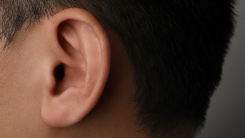No, Light-Emitting Headphones Won’t Cure Your Seasonal Depression

If you tend to feel sad during the darker months of the year, it’s well known that getting some sunlight can help. If you can’t get enough sunlight, a light therapy box (shining in your general direction while you eat breakfast) is the next best thing. But there is also a gadget that some people swear by–earbuds that act as tiny flashlights, shining light into your ear canals. Are they legit?
One skin care TikToker, @emmahoareau1, posted a brief review of her LED headphones for people who “get seasonal affective disorder like me,” concluding that they were “absolutely life changing.” A follow-up video went viral, and commenters began arguing whether it’s possible for light to usefully reach your brain from this device.
Your brain may, in fact, be able to detect light
The most obvious question is: does the light actually get to your brain, and if so, does the brain know it’s there? Surprisingly, the answers to these questions are: yes, and probably.
Scientists have been studying that first question–whether light can shine through brain tissues–for decades. In a 1963 study, a light detector (sort of like a mini solar panel) was mounted on the end of a needle, and then the needle was stuck into brain of a sheep, dog, rabbit, or rat–in some cases dead, in others alive but anesthetized. The investigators shone a bright light at different parts of each animal’s head. They did some of the tests indoors and some in sunlight, and they shielded different parts of the head with aluminum foil to figure out where the light was coming in. Their conclusions: light does reach the brain pretty easily, especially through the temples, where the bone is particularly thin.
We also know that there are light-detecting proteins found in various body parts, including the brain. They may help birds to know what season it is, for example, but so far there is no clear explanation of why humans have these proteins or whether they play a role in seasonal mood disorders.
In 2016, a different group of researchers found evidence that light in the ear canals does something detectable to the brain, but it’s not clear whether that’s good, bad, or whether it accomplishes anything meaningful at all.
The researchers took a photo of a cadaver skull with a Valkee device (similar to the one in the TikTok) in its ears. The light is bright enough to shine through bone into the brain. That’s not the same as saying that the device works, though: “Whether chronic bright light delivery via the ear canals bears clinically applicable benefits is beyond the scope of this study.”
There’s little to no evidence suggesting these headphones do what they say
It’s a big leap between “light can reach the brain” to “this will cure your seasonal affective disorder,” and that’s where this product gets stuck.
The light therapy headset used in the TikTok–which is, as far as I can tell, the only major brand of these–is made by Valkee. Their current product is called the HumanCharger, and it retails for $200.
The company commissioned several studies on their product, and in the early years of their marketing they seemed to lean on these pretty heavily. A 2012 television program in Finland, where Valkee is based, confronted the company about their marketing claims and pointed out to viewers that their studies don’t hold up to scrutiny. Many don’t have adequate placebos, all have conflicts of interest (with company founders and board members as authors), and most were not published in peer-reviewed journals. At the time, their only peer-reviewed paper was in Medical Hypotheses, a journal dedicated to exploring “radical hypotheses which would be rejected by most conventional journals.”
At the time, the company’s website mentioned migraine and jet lag among the conditions their product could treat; notably, the current HumanCharger website avoids any such claims. A marketing video shows a woman entering a hotel room, suitcase rolling behind her, alongside a caption saying the device “gives you a boost of energy.” In another shot, it says that the device combats “the blues.”
I’m not buying it
Research since then hasn’t been any more promising. One 2014 study whose authors include Valkee employees and shareholders claimed that the device decreased people’s scores on depression surveys. But there was no control group; the researchers were just looking for evidence that people who got the highest dose of light would fare better than those who got the lowest dose. They didn’t.
An unrelated group of researchers, experts in chronobiology, tested people’s melatonin levels, subjective sleepiness, and their performance on attention tasks after using a Valkee device. They found no difference between people who used the device versus a “sham” version that didn’t emit light. (Visible light produced a strong response, as you would expect.) They titled their paper: “Extraocular light via the ear canal does not acutely affect human circadian physiology, alertness and psychomotor vigilance performance.”
Other studies on circadian rhythm have not found any solid evidence that our body clock can be entrained by light from the ears, behind the knees, or any other location except the eyes. Interestingly, our eyes’ ability to sense daylight seems to be separate from our sense of vision. Many blind people find that their circadian rhythms get out of sync with daylight, but some have their light-detecting systems intact even without vision.
So there’s no strong evidence for the idea that light-up earbuds do anything; and there’s a decent amount of evidence suggesting that they’re probably bullshit. I feel happy for everyone who bought this device and feels their life is better as a result (lord knows I have my own emotional-support placebos), but I would recommend that you, dear reader, save your money.



